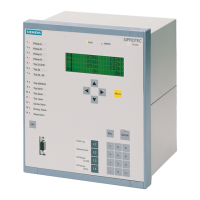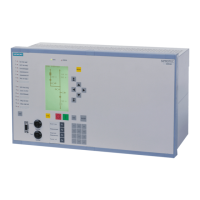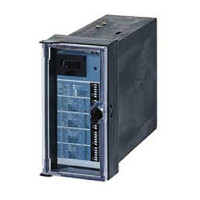loc.3) and the third overcurrent protection as protection of the cable feeder (address 432 DMT/IDMT Ph3
AT = Measuring loc.5).
The same applies also to the assignment of the overcurrent protection for zero sequence current (Section
2.4.1 General) in address 422 DMT/IDMT 3I0 AT. Please keep in mind that this protection function acquires
the sum of the phase currents and is therefore considered as a three-phase protection function. The assign-
ment, however, can differ from the assignment used by the overcurrent protection for phase currents. This
means that in the example shown in Figure 2-2, the overcurrent protection can be easily used for phase
currents (DMT/IDMT Ph AT) at the higher voltage side of the transformer (Side 1), and the overcurrent
protection for residual currents (DMT/IDMT 3I0 AT) at the lower voltage side (Measuring loc.4).
The two additional protection functions in addresses 434 DMT/IDMT3I0-2AT can also be assigned to the
second residual current overcurrent protection and address 436 DMT/IDMT3I0-3AT to the third residual
overcurrent protection.
The same options exist for the unbalanced load protection (address 440 UNBAL. LOAD AT, Section
2.8 Unbalanced Load Protection), which can also be used at a side of the main protection object or at any -
assigned or non-assigned - 3-phase measuring location.
The overload protection (Section 2.9 Thermal Overload Protection) always refers to one
side of the main
protected object. Consequently, address 442 THERM. O/L AT allows to select only a side, not a measuring
location.
Since the cause for overload comes from outside of the protected object, the overload current is a traversing
current. Therefore it does not necessarily have to be detected at the infeeding side.
•
For transformers with tap changer the overload protection is assigned to the non-regulated side as it is
the only side where we have a defined relation between rated current and rated power.
•
For generators, the overload protection is usually on the starpoint side.
•
For motors and shunt reactors, the overload protection is connected to the current transformers of the
feeding side.
•
For series reactors or short cables, any side can be selected.
•
For busbar sections or overhead lines, the overload protection is, generally, not used since climate and
weather conditions (air temperature, wind) change too quickly and it is therefore not reasonable to
calculate the temperature rise. In this case, however, a current-dependent alarm stage is able to warn of
an imminent overload.
The same applies to the second overload protection that is assigned to a side under address 444 THERM. O/L
2 AT.
The overexcitation protection (Section 2.11 Overexcitation Protection) is only possible for devices with voltage
connection, and requires a measuring voltage to be connected and declared in the topology (Section
“Topology of the Protected Object” under margin heading “Assignment of Voltage Measuring Inputs”). It is not
necessary to assign the protection function, since it always evaluates the three-phase measuring voltage at
the voltage input, and the frequency derived from it. The same applies to the undervoltage protection, the
overvoltage protection and the frequency protection.
When using the circuit breaker failure protection (Section 2.17 Circuit Breaker Failure Protection) (address 470
BREAKER FAIL.AT) please make sure that the assignment of this protection function corresponds to that
side or measuring location whose current actually flows through the circuit breaker to be monitored. In the
example shown in Figure 2-2, the assignment must be set in address BREAKER FAIL.AT to Side 1 if you
want to monitor the circuit breaker of the high-voltage side, since both currents flow through the breaker (via
M1 and M2). If on the other hand you want to monitor the circuit breaker of the cable feeder, you set address
BREAKER FAIL.AT to Measuring loc.5. When assigning the circuit breaker failure protection function,
make sure that the breaker auxiliary contacts or feedback information are correctly configured and assigned.
If you do not wish to assign any measuring location or side to the circuit breaker failure protection because
you want only the breaker position to be processed, set BREAKER FAIL.AT to Ext. switchg. 1. In this
case, the protection handles only the breaker position but not any current flow for its operation. This allows
even to monitor a circuit breaker the current of which is not connected to the device. But you have to ensure
that the feedback information of this breaker is correctly connected and configured.
In 7UT613/63x, you can monitor another m.c.b. using the second circuit breaker failure protection. The
considerations for the assignment in address 471 BREAKER FAIL2AT correspond to those for the first circuit
breaker failure protection.
Functions
2.1 General
70 SIPROTEC 4, 7UT6x, Manual
C53000-G1176-C230-5, Edition 09.2016
